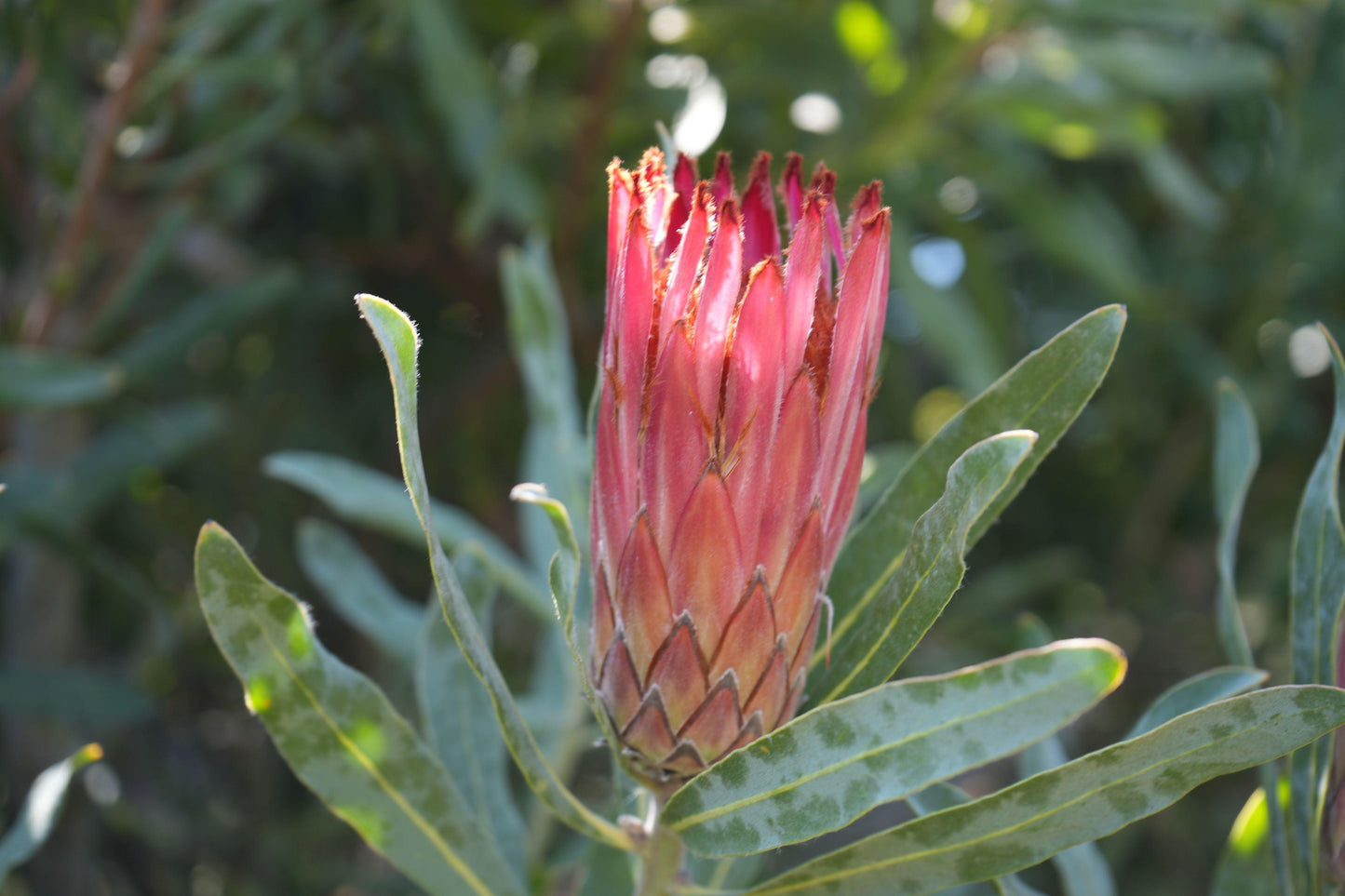Bonte Farm
Protea longifolia: Unleash Dramatic Beauty with the Strap-Leaf Protea
Protea longifolia: Unleash Dramatic Beauty with the Strap-Leaf Protea
Couldn't load pickup availability
🌿 Protea longifolia: The Long-Leaved, Fine-Textured Shrub
The Protea longifolia, aptly named the Long-Leaved Protea, is a beautiful and highly adaptable species native to the Cape region of South Africa.2 This handsome evergreen shrub is distinguished by its unique, slender, elongated leaves and its naturally dense, rounded form, offering a finer, more delicate texture than many other Protea varieties. It produces attractive, smaller cup-shaped flowers that feature vibrant cream to yellow-green bracts often tipped with soft pink or burgundy. P. longifolia is a resilient, low-maintenance specimen for Mediterranean, coastal, and xeriscape gardens.3 Its superior drought tolerance and ability to thrive in challenging, low-nutrient soils make it an excellent choice for adding unique texture and structure to the garden.
Botanical Characteristics
|
Characteristic |
Detail |
|
Scientific Name |
Protea longifolia (The Species) |
|
Common Names |
Long-Leaved Protea, Long-Leaf Sugarbush. |
|
Growth Habit |
A sturdy, rounded evergreen shrub with a naturally dense and bushy form. |
|
Foliage |
Features the distinguishing trait of very long, slender, lanceolate leaves (up to 8 inches long) that are gray-green and leathery. |
|
Flowers |
Small to medium-sized, cup-shaped flower heads (bracts), typically 3–4 inches in diameter. Color ranges from pale cream to yellow-green, often with pink or maroon tips. |
|
Flowering Season |
Known for its extended bloom period, typically flowering heavily from late fall through spring, providing cool-season interest. |
|
Texture |
Provides a fine, weeping texture due to its long, narrow leaves, setting it apart from broader-leaved Proteas. |
Mature Size
P. longifolia maintains a compact, dense size, ideal for many landscape uses.
- Height: Typically reaches a manageable 4–6 feet (1.2–1.8 meters) tall.
- Spread: Achieves a comparable, dense spread of 4–6 feet (1.2–1.8 meters) wide.
- Its fine-textured foliage creates a soft, mounding appearance.
USDA Hardiness Zone
This species is best suited for USDA Hardiness Zones 9–11. It requires a mild, nearly frost-free climate and thrives in full sun, especially in coastal and dry-summer regions. It is intolerant of sustained freezing temperatures and humid tropical heat.
Cultivation and Care
|
Aspect |
Care Instructions |
|
Sunlight |
Requires full sun (a minimum of 6 hours of direct sun daily) and excellent air circulation to ensure dense growth and abundant blooms. |
|
Soil |
Essential: Demands perfectly well-drained, acidic soil (pH 5.0–6.0). Thrives in sandy, gritty, low-nutrient soils and must not sit in heavy, wet clay. |
|
Water |
Highly drought-tolerant once established. Water deeply during the first year. Mature plants require minimal summer water; overwatering is the primary threat. |
|
Fertilizer |
Crucial: ABSOLUTELY AVOID all phosphorus fertilizers. Proteas are extremely phosphorus-sensitive. Use a specialized, low-phosphorus formula for Proteaceae, or none at all. |
|
Pruning |
Benefits from regular light tipping to maintain a dense, rounded shape. Flowers should be cut heavily for display to encourage new basal growth. |
Landscape Use
- Specimen Plant: Used as a unique focal point to introduce fine texture among broad-leaved plants.
- Border Plant: Excellent for planting in sunny borders where its rounded shape can be appreciated.
- Erosion Control: Suitable for planting on dry, sunny slopes where good drainage is present.
- Xeriscape Design: A reliable, low-water, low-fertility plant for arid and Mediterranean-style gardens.
Wildlife Attraction
The smaller flowers still produce sweet nectar, making them attractive to nectar-feeding birds, which assist with pollination.4 Planting P. longifolia helps diversify the garden's offerings and attracts hummingbirds during its cool-season bloom.
Pest and Disease Resistance
Protea longifolia is generally a hardy and robust species when its crucial drainage needs are met. The main issues are root rot and collar rot, which are caused by poor soil drainage or overwatering—this is the single most critical factor to avoid.
Propagation
The species is commonly propagated from seed, though this may result in genetic variation. For home garden use, propagation can also be achieved through semi-hardwood cuttings, generally taken during the warmer months, to ensure desirable parent traits are maintained.
Share


FAQs
Got a question? We are here to answer


